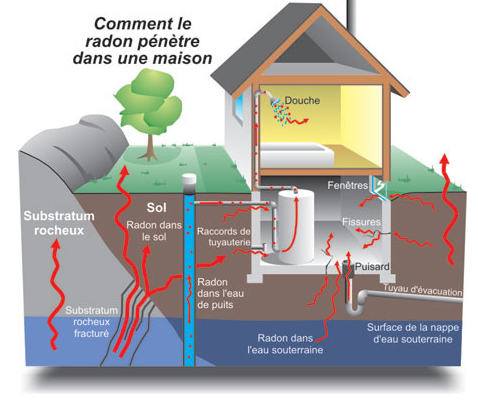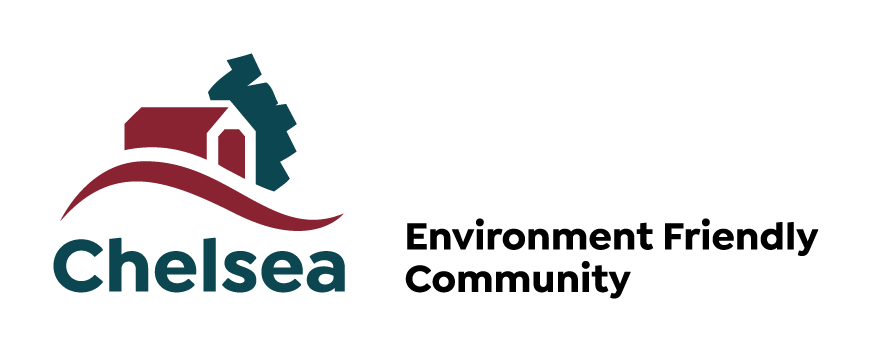If your house uses water from a well, it is recommended to test for radon in air on each habited level of your house.
Why?
Radon is a gas that dissolves in water. If your well water has a high radon content from contact with rock that is high in radon, the water you use for domestic activities can contribute to increased radon levels in the air. When the water is agitated and/or heated, the microscopic radon bubbles in it are released—ending up in the air.
Radon is a radioactive gas produced naturally by the decay of uranium in the earth’s crust. When radon is released from the ground into the outdoor air, it gets diluted to low concentrations and is not a concern. The only way to measure the radon level in a house is to test it.
Radon concentration in water is also highly variable. Drinking water can be obtained from groundwater sources such as springs, wells and boreholes. Groundwater often flows through rock formations which contain natural uranium and radon producing radium. As radon is a water soluble gas, these sources of water normally have much higher concentrations of radon than surface water from rivers, lakes and streams.
When radon enters a confined space such as a house, it can sometimes accumulate to high concentrations that can pose a health risk, either to develop lung cancer in the long term. The level of risk depends on the radon concentration and the number of years of exposure. It is estimated that in Quebec, 10% of lung cancer deaths are associated with radon exposure.
Whether your house is new or old, radon tends to accumulate in the lower and less ventilated rooms, like the basement for example. The only way to know if you have a radon problem in your home is to measure its concentration.

Souce: Ressources naturelles Canada, 2008
Step 1 :
- Test for radon in the air on each level of your house where a person spends in average at least 4 hours per day.
- Use long-term measurement devices (min. 3 months) during the heating season, as recommended by Health Canada.
Step 2 :
- If you get a result in air that is higher than Health Canada’s guideline (200 Bq/m3), consider testing your well water. This helps to determine if your well water contributes to radon in air in your house, in which case mitigation measures on your well would be appropriate.
Reduced-price radon test kits are available at the Chelsea town hall for $27 for an air test and $85 for a water test (taxes included).
The models offered are as follows:
- AccuStar Canada. Long Term Radon Test Kit - Alpha Track AT100
- AccuStar Canada. Test Kit for Radon in Water - Liquid Scintillation WT100
You can also get a radon test at various locations (non-exhaustive list):
- Certain hardware stores
- Québec Lung Association
- AccuStar Canada
- For a list of test providers sold online to make yourself (anglais seulement)
For a list of professionals who are certified to test and/or mitigate your radon, you can search for a professional on the Canadian National Radon Proficiency Program (C-NRPP) website. This certification program is recognized by Health Canada and Ministère de la Santé et des Services sociaux du Québec.
There are a number of techniques and treatments available to address radon levels in your home. The Health Canada guide offers a complete overview of the different mitigation methods available.
Radon - Reduction Guide for Canadians
For a list of professionals who are certified to test and/or mitigate your radon, you can search for a professional on the Canadian National Radon Proficiency Program (C-NRPP) website. This certification program is recognized by Health Canada and Ministère de la Santé et des Services sociaux du Québec.
To provide a framework for radon mitigation measures in new construction, the Municipality of Chelsea has several radon mitigation provisions in Section 9.5 of its Construction By-law, “Protection against radon and soil gases.”
The information on this page has been taken from documents produced by Health Canada, the Association pulmonaire du Québec, and Ministère de la Santé et des Services sociaux du Québec.
Association pulmonaire du Québec
Canadian Association of Radon Scientists and Technologists
Centre intégré de santé et de services sociaux de l’Outaouais (CISSSO) (French only)
Ministère de la Santé et des Services Sociaux du Québec : Residential radon
Heanlth Canada - Reduction Guide for Canadians
Sources
The information on this page has been taken from documents produced by Health Canada, L'Association pulmonaire du Québec and the Ministère de la Santé et des Services sociaux du Québec.
Information
Environment Department
This page was last updated on October 1, 2025

